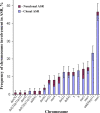Chinese hamster ovary cell line DXB-11: chromosomal instability and karyotype heterogeneity
- PMID: 33596973
- PMCID: PMC7888135
- DOI: 10.1186/s13039-021-00528-3
Chinese hamster ovary cell line DXB-11: chromosomal instability and karyotype heterogeneity
Abstract
Background: Chinese hamster ovary cell lines, also known as CHO cells, represent a large family of related, yet quite different, cell lines which are metabolic mutants derived from the original cell line, CHO-ori. Dihydrofolate reductase-deficient DXB-11 cell line, one of the first CHO derivatives, serves as the host cell line for the production of therapeutic proteins. It is generally assumed that DXB-11 is identical to DUKX or CHO-DUK cell lines, but, to our knowledge, DXB-11 karyotype has not been described yet.
Results: Using differential staining approaches (G-, C-banding and Ag-staining), we presented DXB-11 karyotype and revealed that karyotypes of DXB-11 and CHO-DUK cells have a number of differences. Although the number of chromosomes is equal-20 in each cell line-DXB-11 has normal chromosomes of the 1st and 5th pairs as well as an intact chromosome 8. Besides, in DXB-11 line, chromosome der(Z9) includes the material of chromosomes X and 6, whereas in CHO-DUK it results from the translocation of chromosomes 1 and 6. Ag-positive nucleolar organizer regions were revealed in the long arms of chromosome del(4)(q11q12) and both chromosome 5 homologues, as well as in the short arms of chromosomes 8 and add(8)(q11). Only 19 from 112 (16.96%) DXB-11 cells display identical chromosome complement accepted as the main structural variant of karyotype. The karyotype heterogeneity of all the rest of cells (93, 83.04%) occurs due to clonal and nonclonal additional structural rearrangements of chromosomes. Estimation of the frequency of chromosome involvement in these rearrangements allowed us to reveal that chromosomes 9, der(X)t(X;3;4), del(2)(p21p23), del(2)(q11q22) /Z2, der(4) /Z7, add(6)(p11) /Z8 are the most stable, whereas mar2, probably der(10), is the most unstable chromosome. A comparative analysis of our own and literary data on CHO karyotypes allowed to designate conservative chromosomes, both normal and rearranged, that remain unchanged in different CHO cell lines, as well as variable chromosomes that determine the individuality of karyotypes of CHO derivatives.
Conclusion: DXB-11and CHO-DUK cell lines differ in karyotypes. The revealed differential instability of DXB-11 chromosomes is likely not incidental and results in karyotype heterogeneity of cell population.
Keywords: CHO DXB-11 cell line karyotype; CHO chromosomes; Chinese hamster ovary cells; Chromosomal instability; Karyotype heterogeneity.
Conflict of interest statement
The authors declare that they have no competing interests.
Figures






Similar articles
-
[COMPARATIVE CYTOGENETIC ANALYSIS OF MONOLAYER AND SUSPENSION CHINESE HAMSTER OVARY CELL LINES CHO(dhfr-)].Tsitologiia. 2015;57(7):491-8. Tsitologiia. 2015. PMID: 26591061 Russian.
-
Growth Rate Changes in CHO Host Cells Are Associated with Karyotypic Heterogeneity.Biotechnol J. 2018 Mar;13(3):e1700230. doi: 10.1002/biot.201700230. Epub 2017 Sep 22. Biotechnol J. 2018. PMID: 28865132
-
A framework to quantify karyotype variation associated with CHO cell line instability at a single-cell level.Biotechnol Bioeng. 2017 May;114(5):1045-1053. doi: 10.1002/bit.26231. Biotechnol Bioeng. 2017. PMID: 27922175
-
Submicroscopic terminal deletion of 1p36.3 and Xp23 hidden in complex chromosome rearrangements: independent mechanism of telomere restitution on the two chromatids.Am J Med Genet A. 2003 Mar 15;117A(3):261-7. doi: 10.1002/ajmg.a.10108. Am J Med Genet A. 2003. PMID: 12599190 Review.
-
Prenatal diagnosis of sex chromosome mosaicism with two marker chromosomes in three cell lines and a review of the literature.Mol Med Rep. 2019 Mar;19(3):1791-1796. doi: 10.3892/mmr.2018.9798. Epub 2018 Dec 24. Mol Med Rep. 2019. PMID: 30592288 Review.
Cited by
-
Tandem Repeat Diversity in Two Closely Related Hamster Species-The Chinese Hamster (Cricetulus griseus) and Striped Hamster (Cricetulus barabensis).Biomedicines. 2022 Apr 18;10(4):925. doi: 10.3390/biomedicines10040925. Biomedicines. 2022. PMID: 35453675 Free PMC article.
-
Genomic and Phenotypic Characterization of CHO 4BGD Cells with Quad Knockout and Overexpression of Two Housekeeping Genes That Allow for Metabolic Selection and Extended Fed-Batch Culturing.Cells. 2025 May 11;14(10):692. doi: 10.3390/cells14100692. Cells. 2025. PMID: 40422195 Free PMC article.
References
Grants and funding
LinkOut - more resources
Full Text Sources
Other Literature Sources
Research Materials

